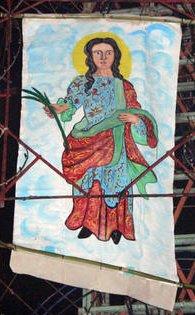Saint Prisca | |
|---|---|
 | |
| Died | late 1st century |
| Venerated in | Roman Catholic Church, Anglican Communion, Orthodox Church |
| Major shrine | Santa Prisca |
| Feast | January 18 |
Saint Prisca was a young Roman woman allegedly tortured and executed for her Christian faith. The dates of her birth and death are unknown. She is revered as a pre-schism Western saint and martyr by the Orthodox Church and as a saint and a martyr by the Roman Catholic Church and the Anglican Communion. Though some legends suggest otherwise, scholars do not believe she is the Priscilla (Prisca) of the New Testament couple, Priscilla and Aquila, who were friends of the Apostle Paul.[1]
Especially in England, she is honored as a child martyr. January 18 is her feast day.
Legend
Legend says that Saint Prisca was of a noble family. At age thirteen, she was accused of Christianity before Emperor Claudius. He ordered her to make a sacrifice to the god Apollo. When she refused because of her Christian faith, she was beaten and sent to prison.
Upon her release from prison, she still held steadfastly to her faith in Jesus Christ. This time her punishment included flogging, the pouring of boiling tallow upon her, and a second imprisonment. She was at last thrown to a lion in the amphitheater, but it quietly lay down at her feet. The Italian poet Martha Marchina (1600-1646) describes this moment of Prisca's martyrdom in a pair of poems in her book Musa Posthuma where the lion's humane nature is contrasted against human savagery.[2]
She was starved for three days in a slaves' prison house, and then tortured upon the rack. Pieces of flesh were next torn from her body with iron hooks, and she was thrown on a burning pile.[3]
She miraculously still remained alive, but was beheaded at the tenth milestone on the Via Ostiensis—the road from Rome to Ostia. The Christians buried her body in a catacomb at the place of her death, where now stands a church of St. Prisca and where previously stood a very early title church, the Titulus Priscoe, mentioned in the fifth century and likely built in the fourth.[1]
According to Catholic theologian Johann Kirsch, extant narratives are unhistorical and their details impossible.[4]
External links
- (in Italian) Santa Prisca
- (in English) St. Prisca at the Catholic Encyclopedia
References
- ^ a b Kirsch, Johann Peter. "St. Prisca." The Catholic Encyclopedia. Vol. 12. New York: Robert Appleton Company, 1911. 13 Jun. 2009 .
- ^ Marchina, Martha (1662). Musa Posthuma. Rome. p. 71.
- ^ Brown, Abbie Farwell. "Saint Prisca, the Child Martyr." Baldwin Online Children's Project. Online: http://www.mainlesson.com/display.php?author=brown&book=saints&story=prisca. June 13, 2009.
- ^ Kirsch, Johann Peter. "St. Prisca." The Catholic Encyclopedia. Vol. 12. New York: Robert Appleton Company, 1911. 13 Jun. 2009 .